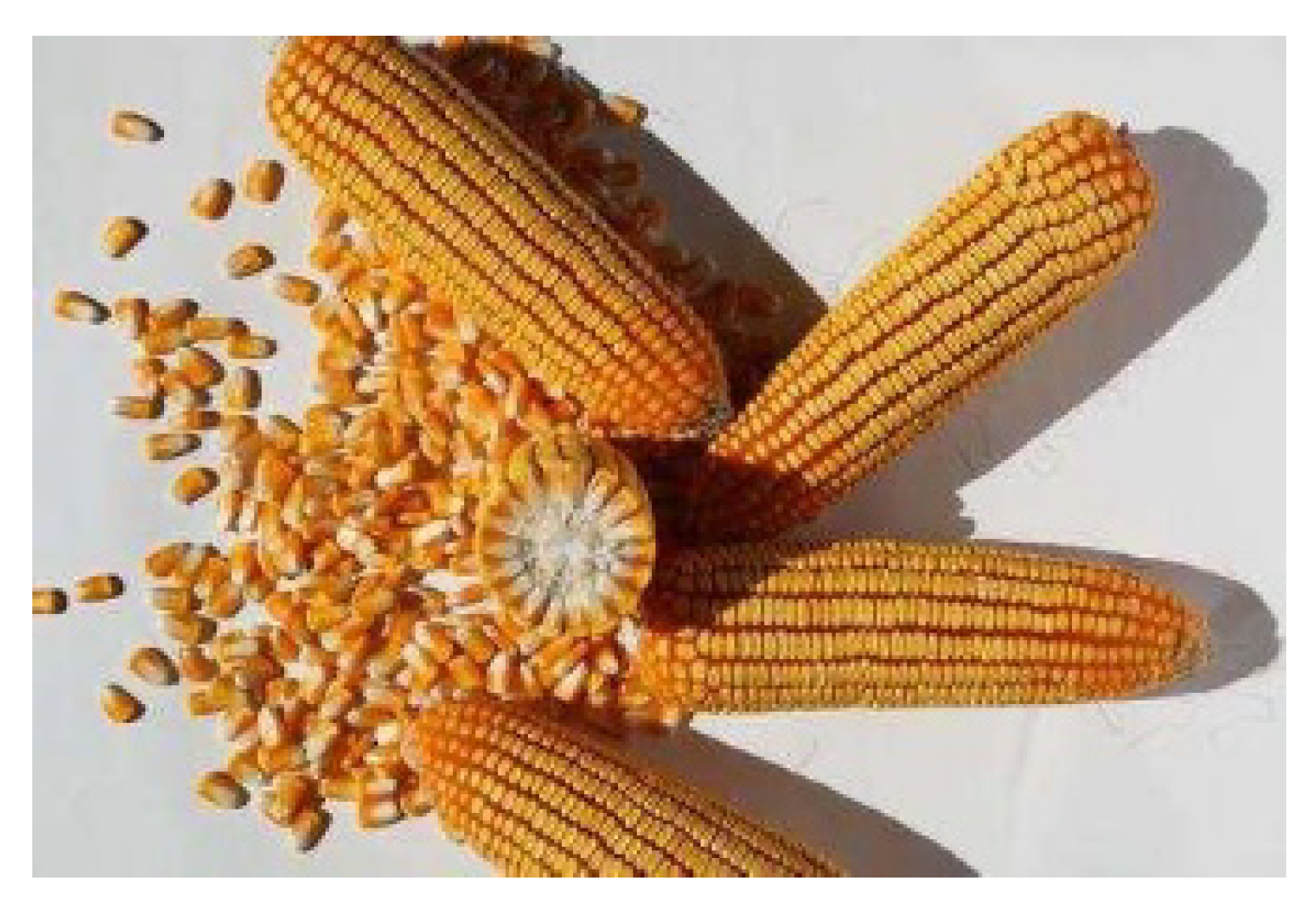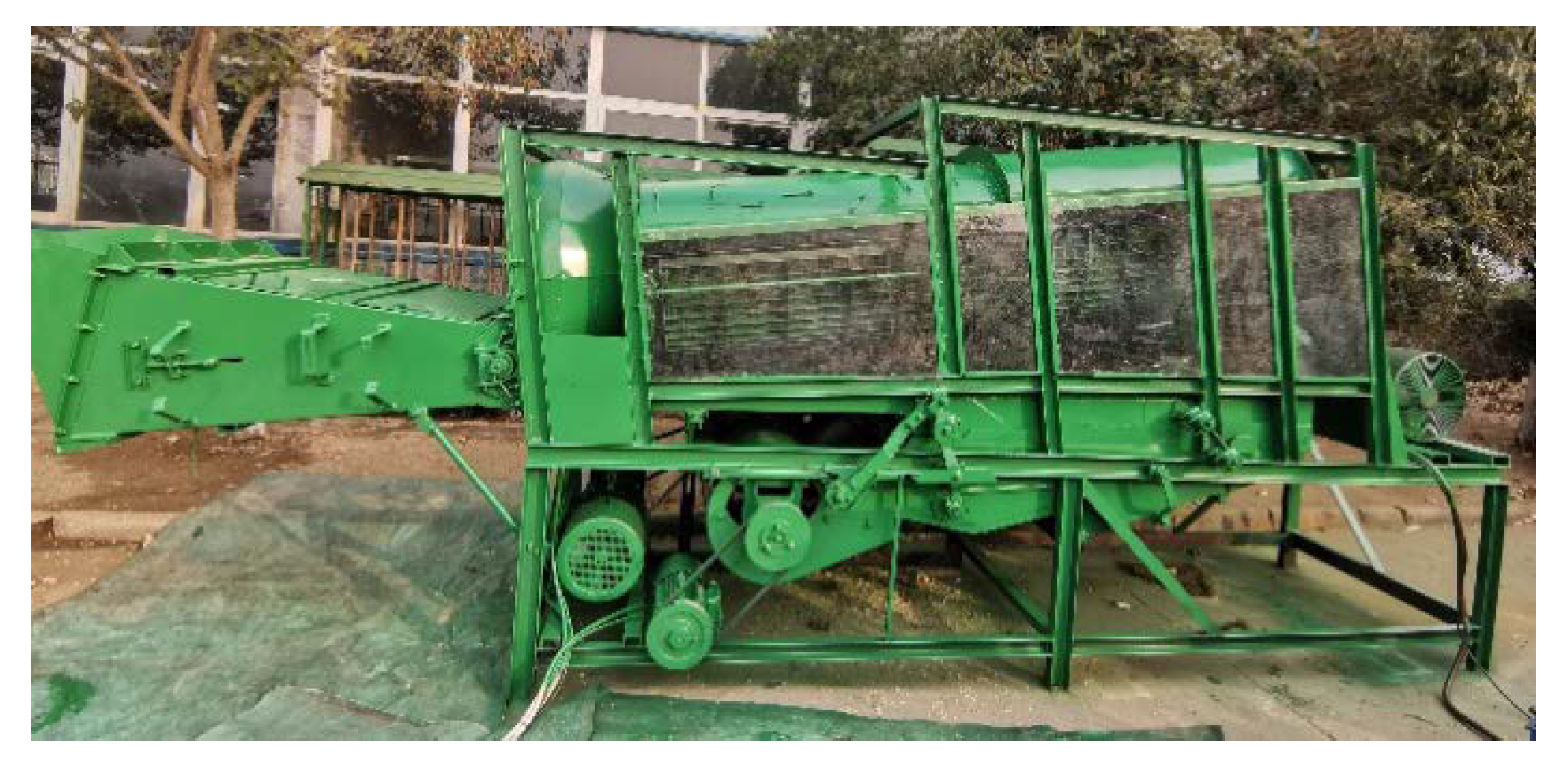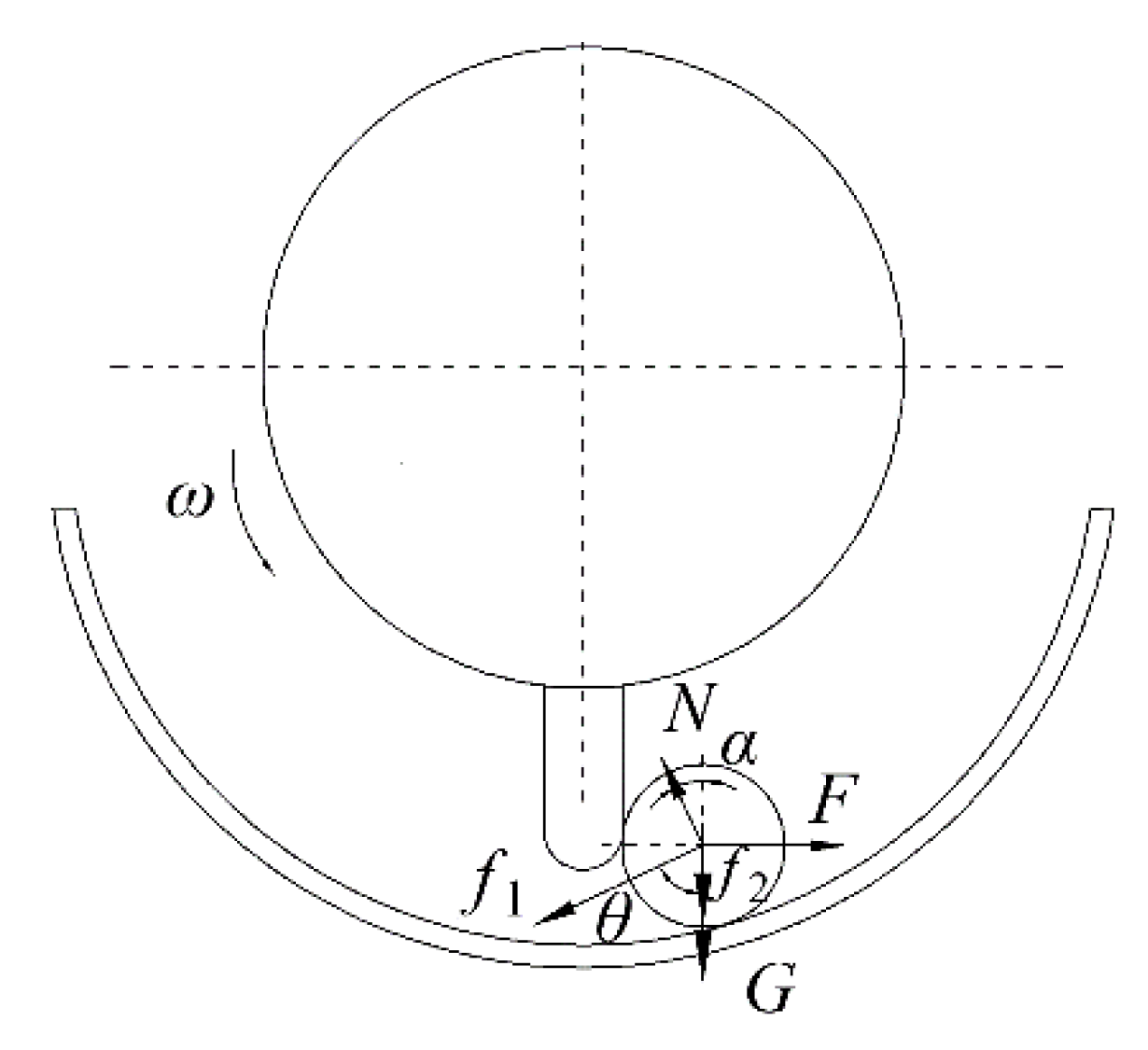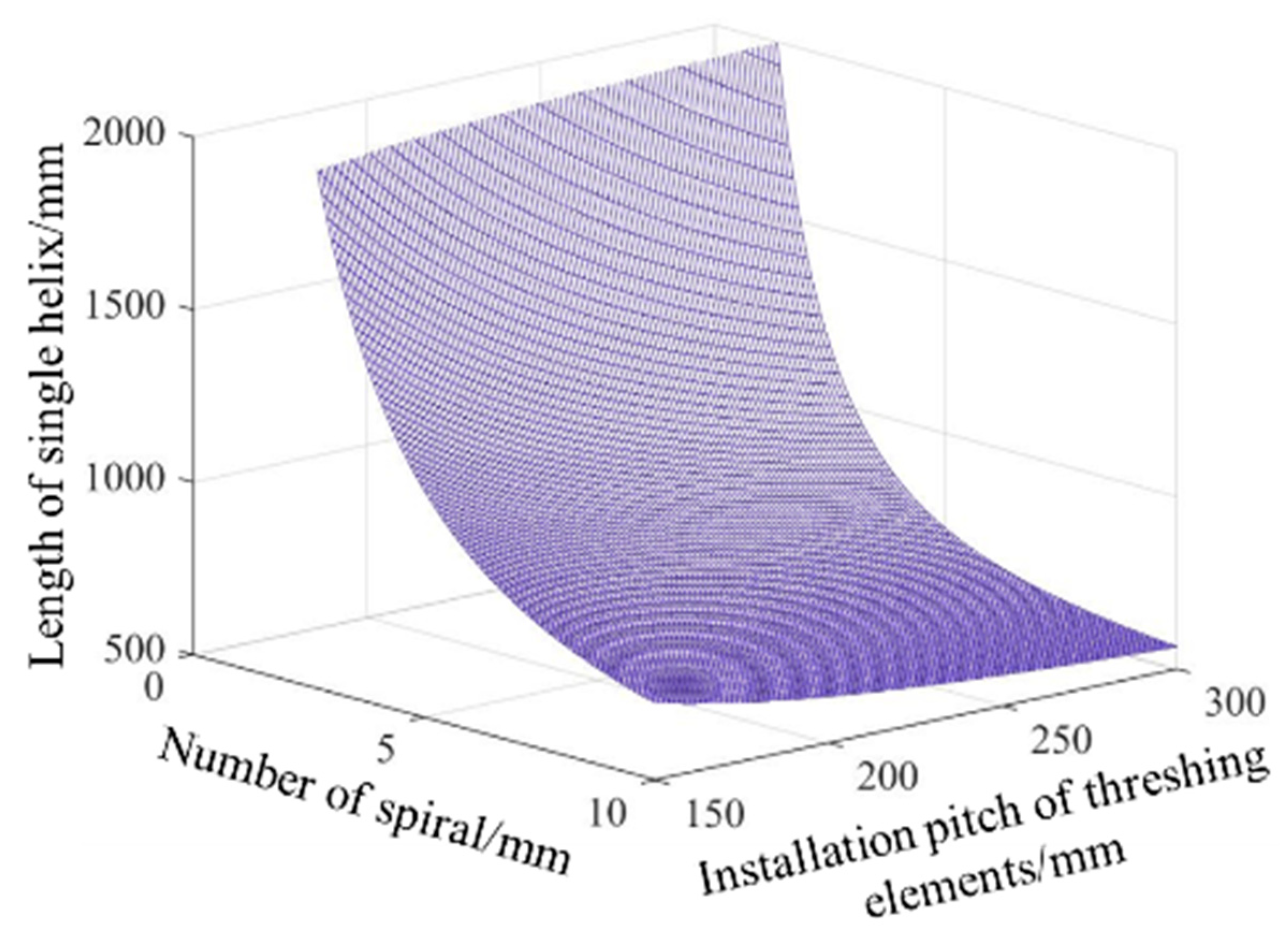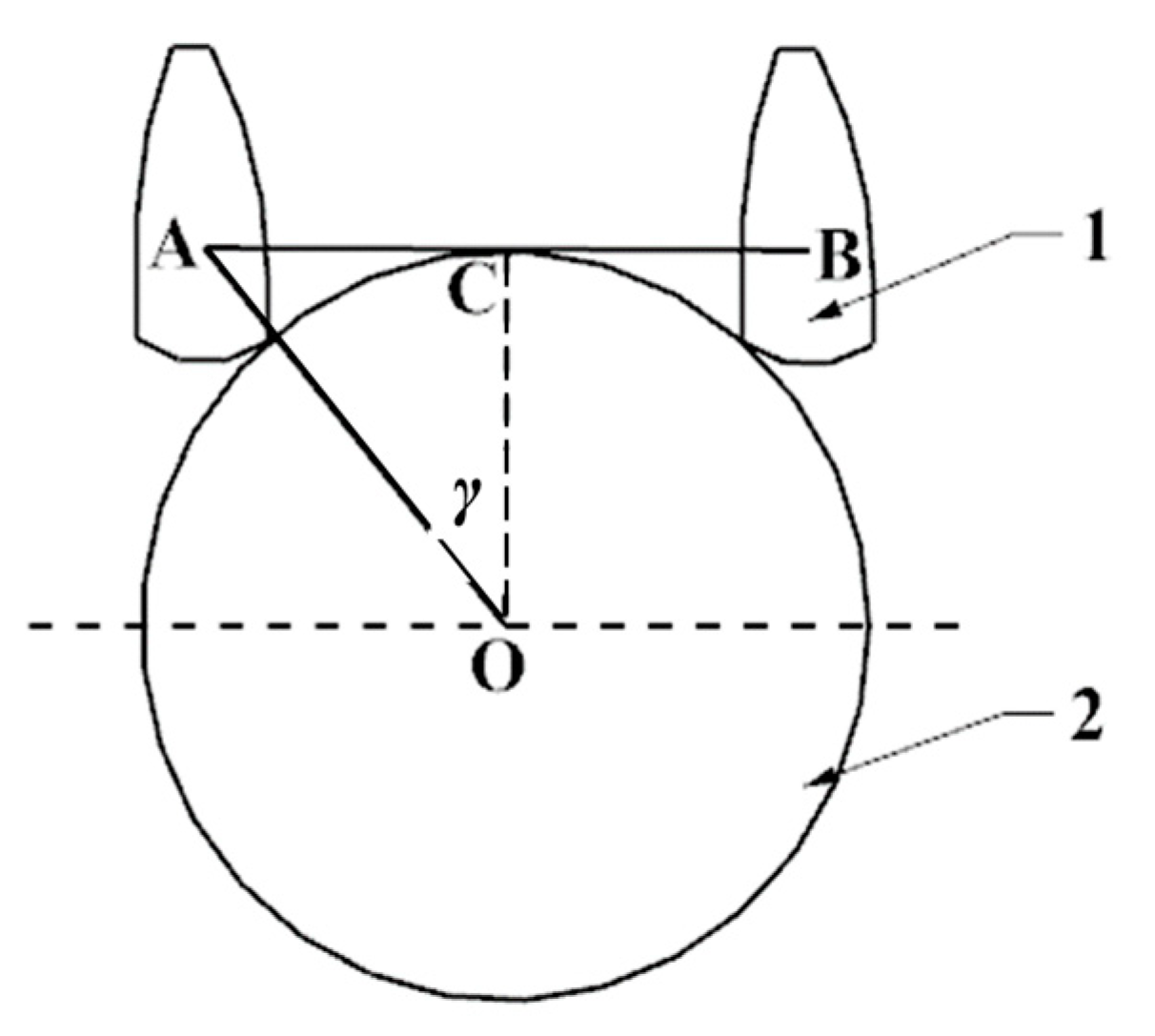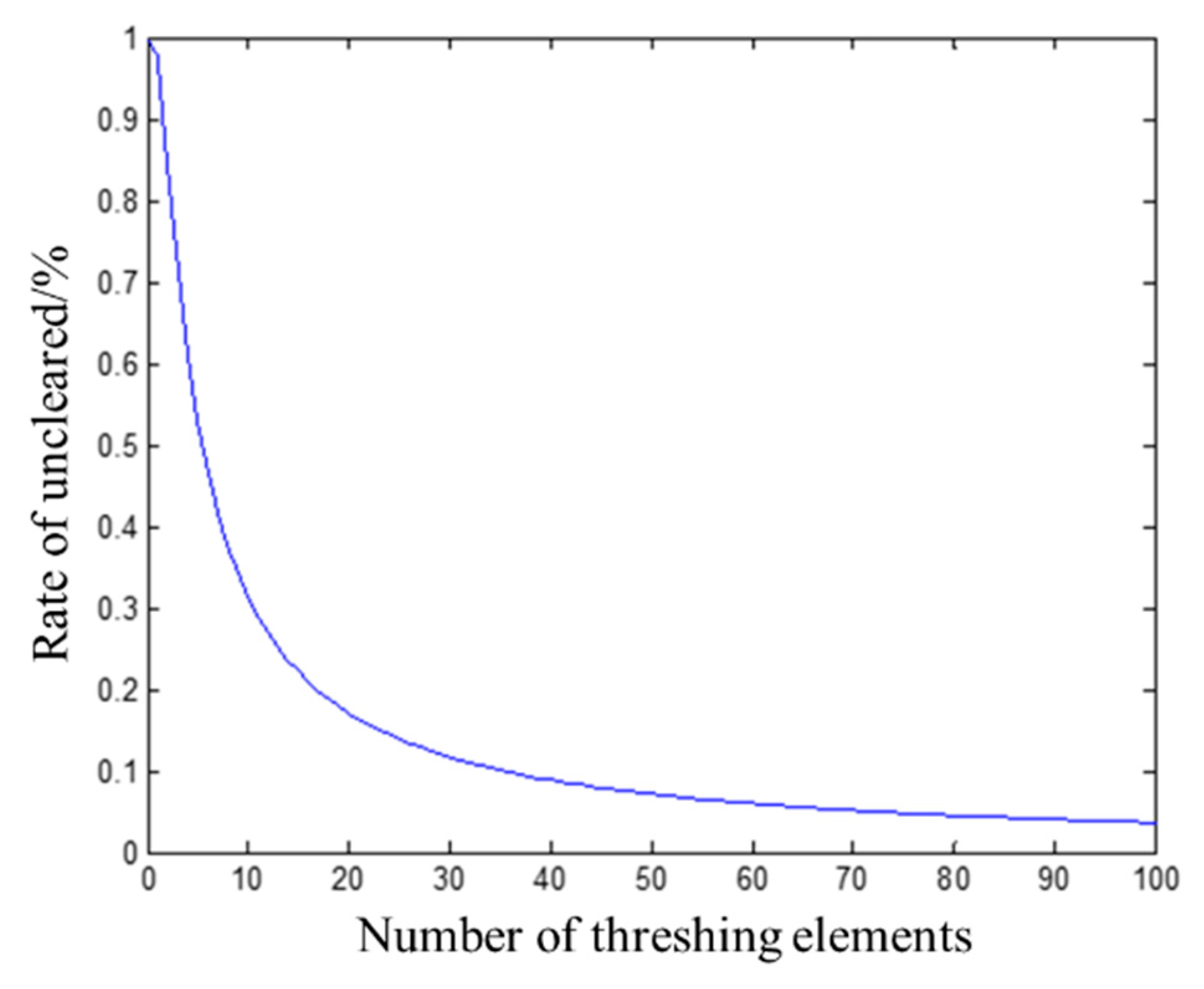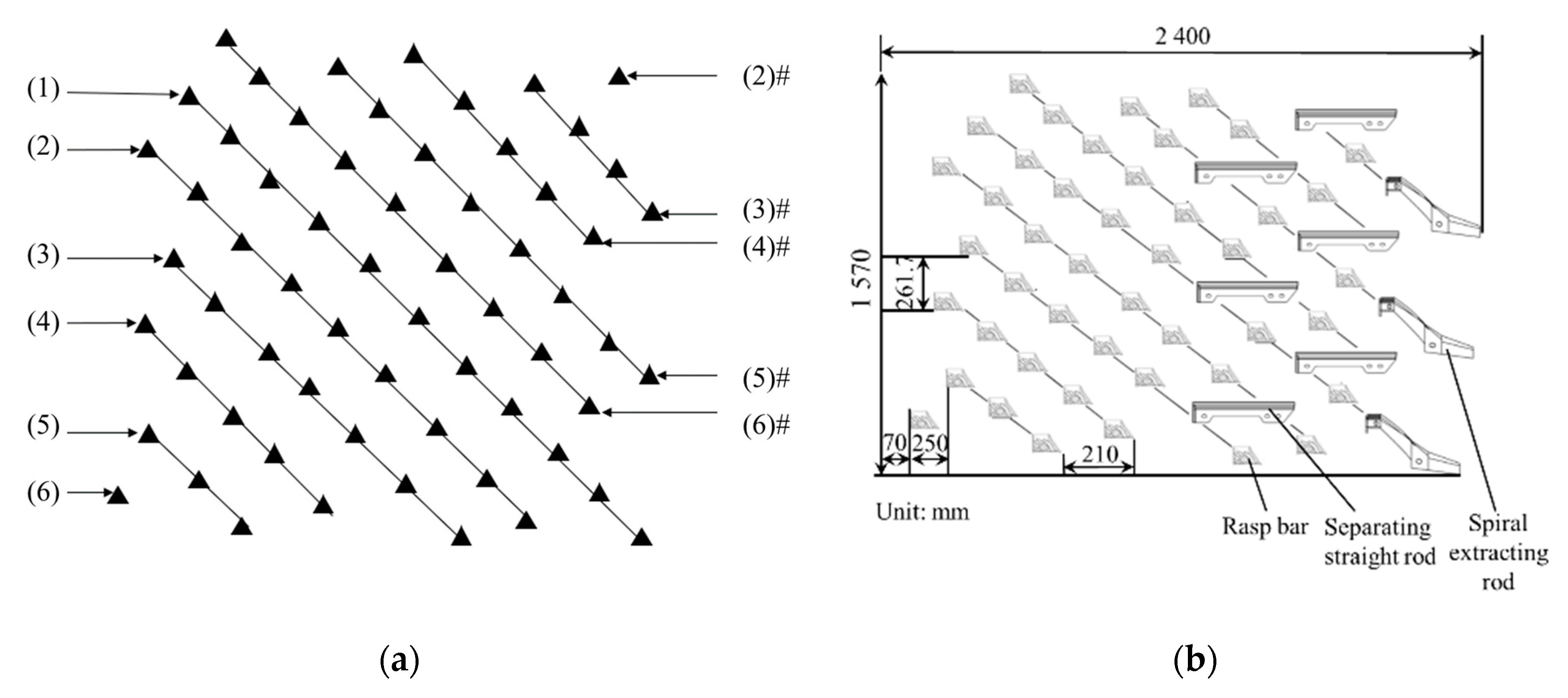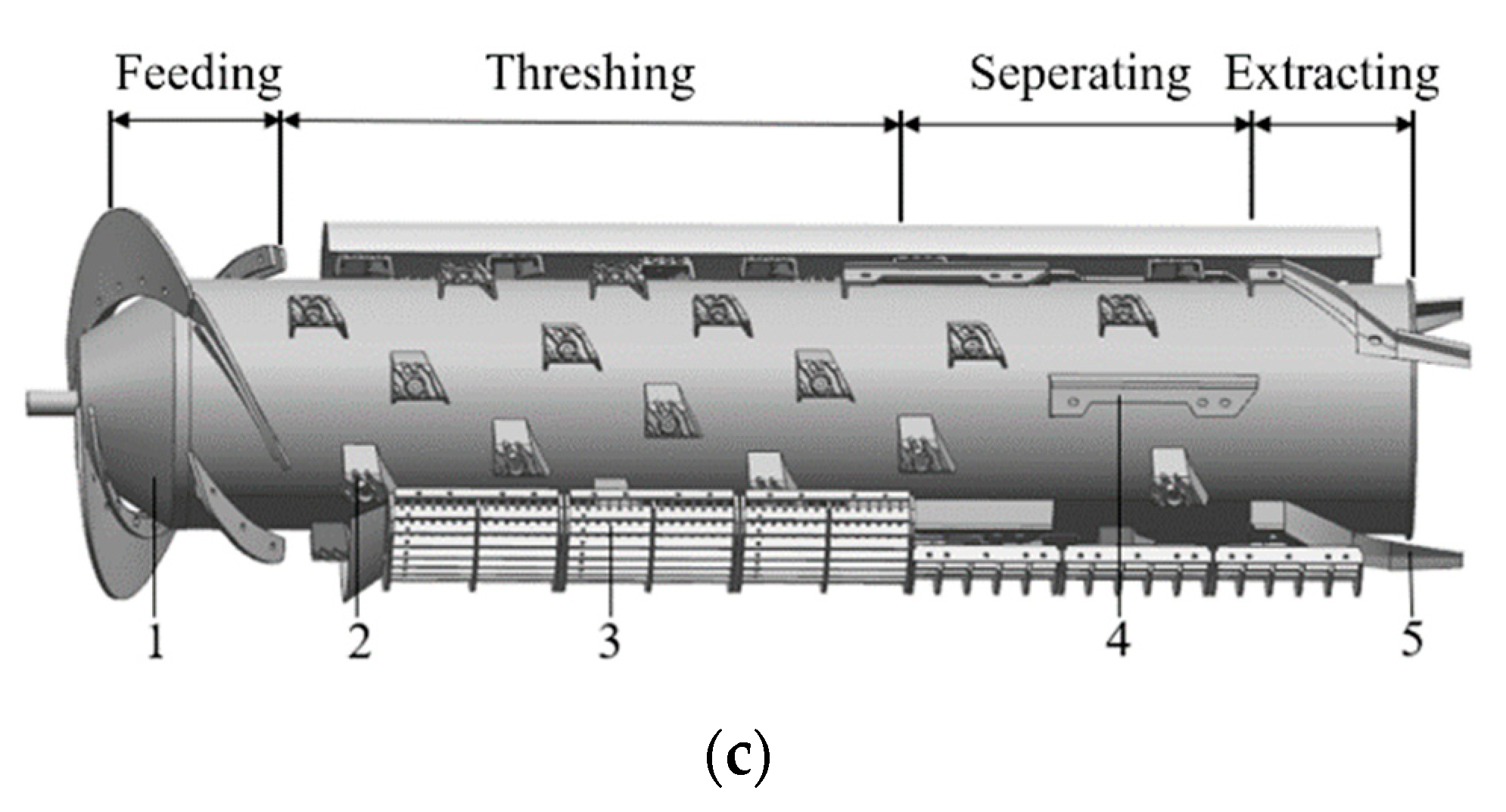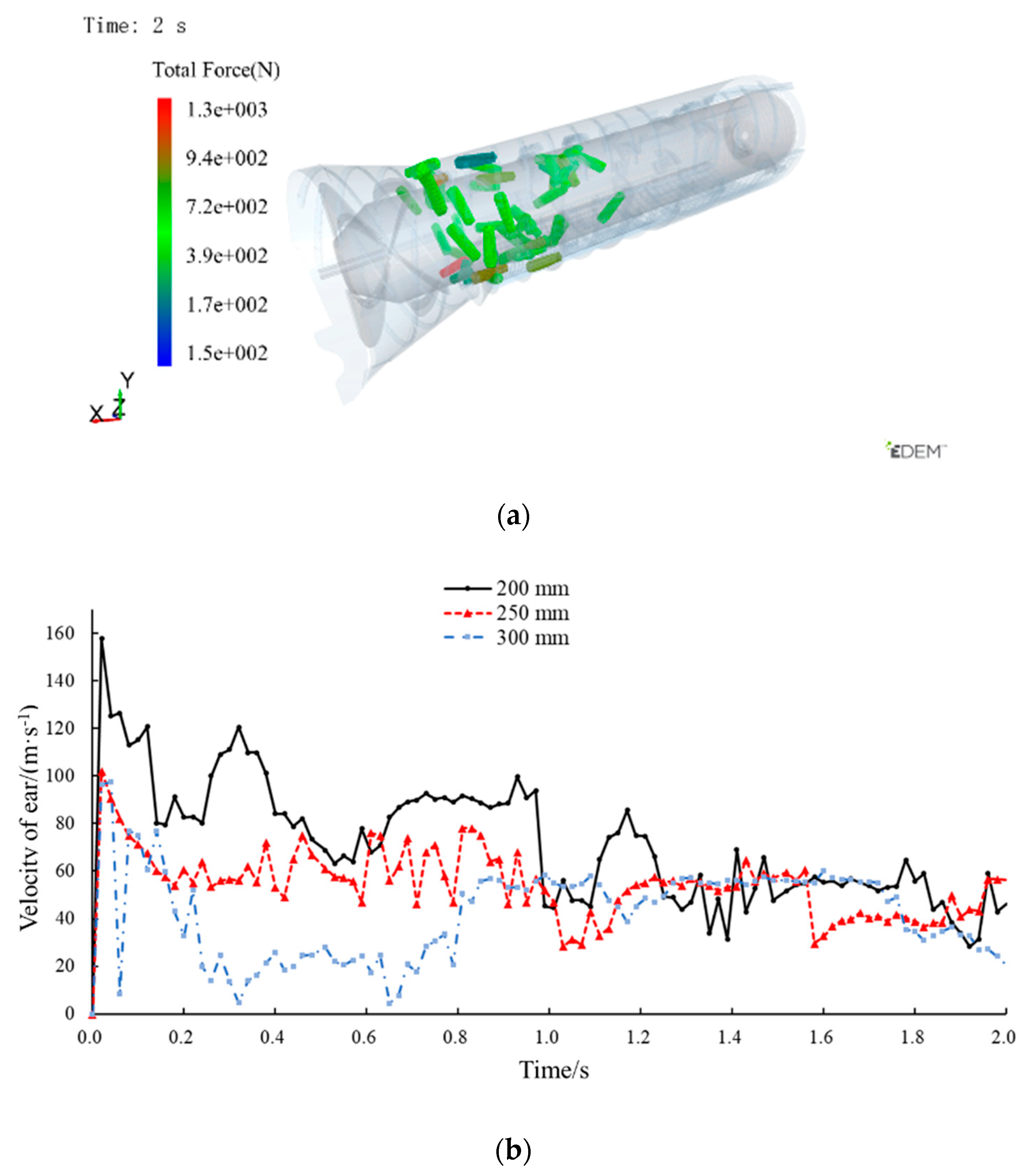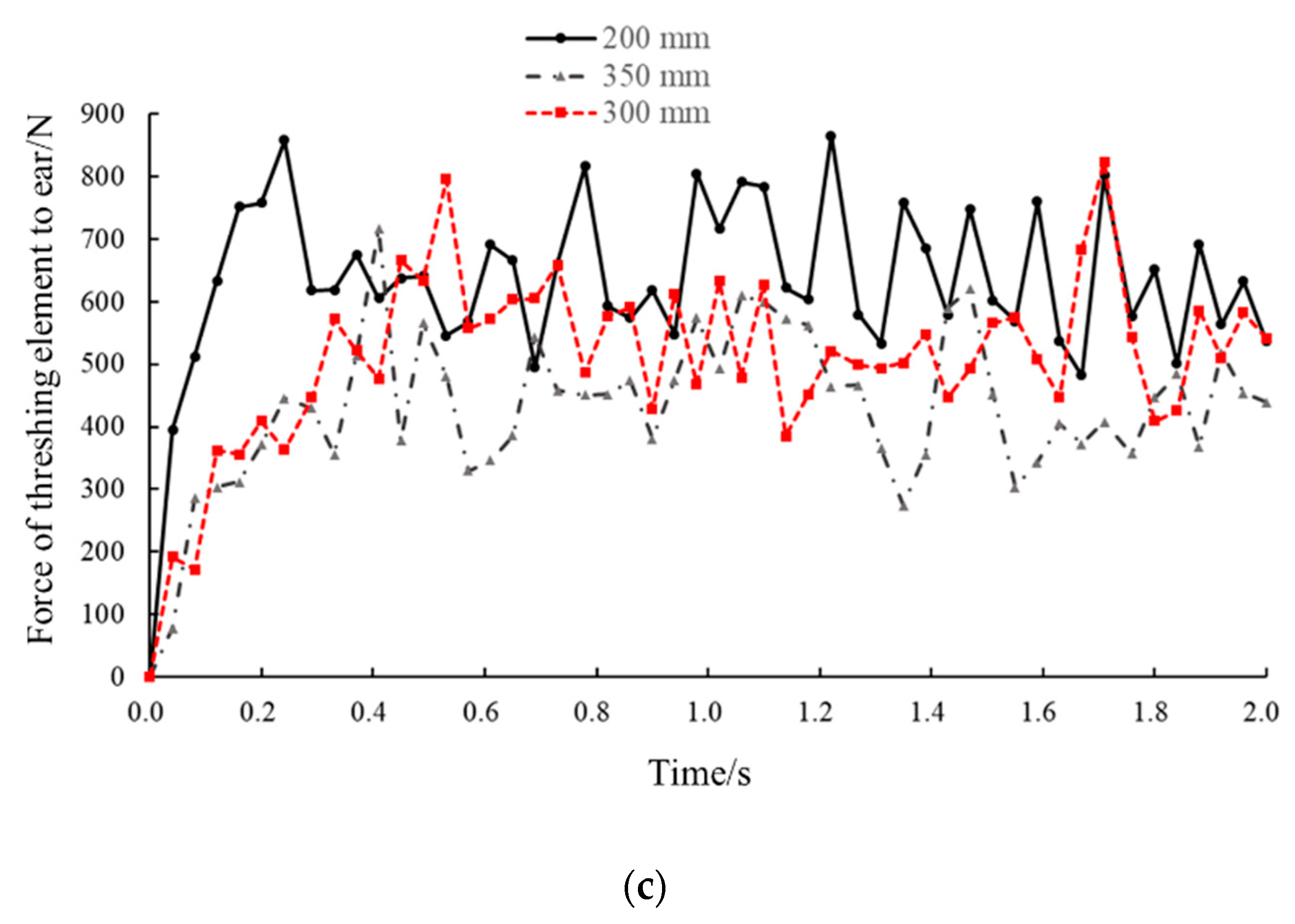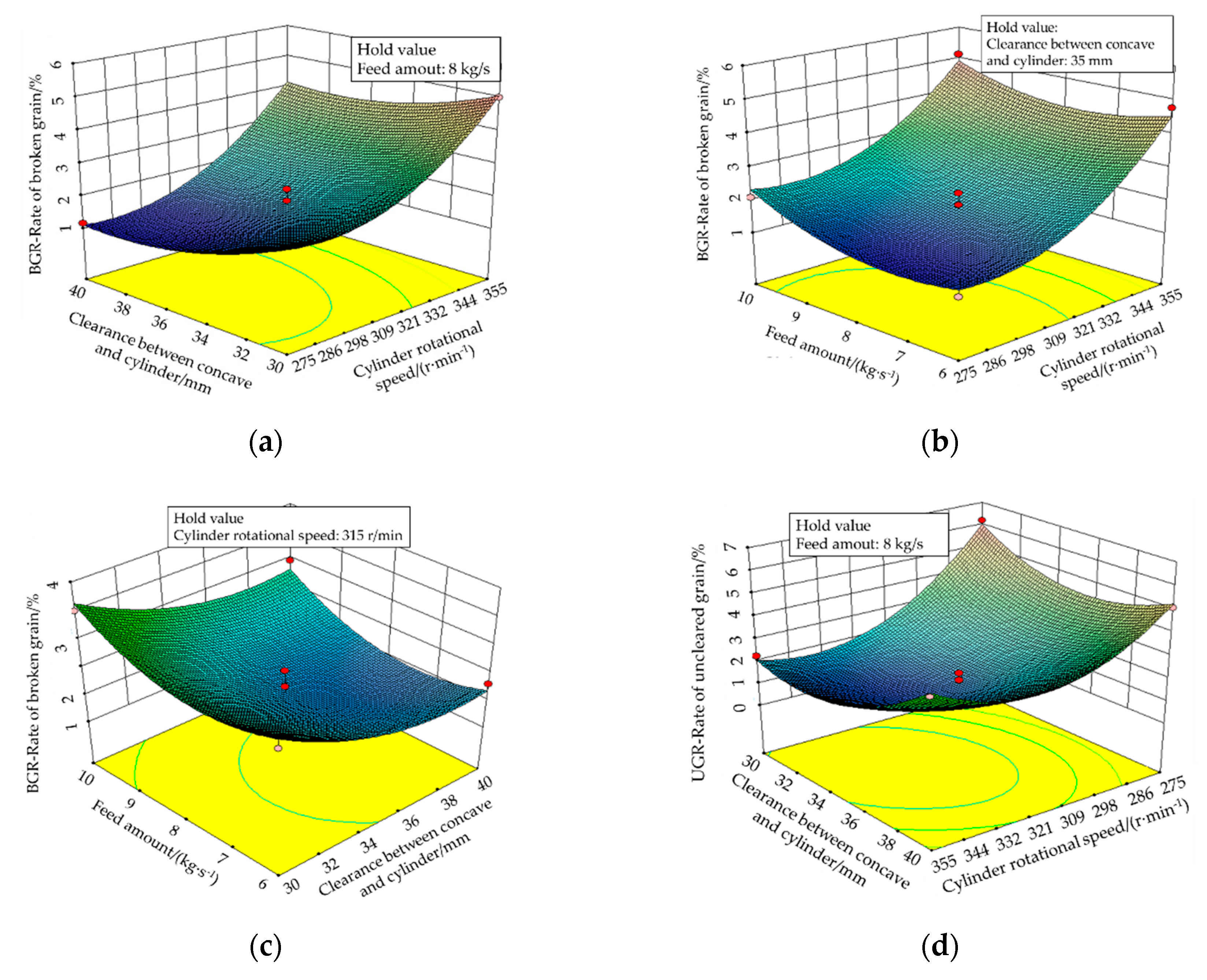1. Introduction
Corn is one of the main crops in China; the total production was 25.717 million tons in 2018 [
1]. Corn harvesting is usually carried out when the moisture content of the grain is within the range of 20% to 35%, after a long time of drying, then threshed by a small thresher after moisture content reduced to about 15% [
2,
3]. This method has some disadvantages, such as a long treatment cycle and high labor intensity and operating costs, which cannot meet the requirements of modern corn production operations. Therefore, the corn harvesting operations in China that have gradually changed to directly harvested grain are of great significance to shorten harvest cycles, save production costs, improve operational efficiency, and promote overall agricultural mechanization [
4,
5].
The threshing device, as one of the key components of corn grain direct harvesters, determines the operation efficiency of the harvester. The rate of broken grain (BGR) and the rate of uncleared grain (UGR) are important indexes to evaluate the operation quality of threshing. Grain with high moisture content is easily damaged during threshing [
6]; thus, the threshing method, structure, and parameters are important to improve the quality of the direct grain harvesting operation. Countries represented by the United States, Italy, and Germany generally use combined harvesting machinery to directly harvest grain because of the vast land planting areas, single crop variety, and mature farm management models. Some large-scale corn combine harvesters developed by famous agricultural machinery brands such as John Deere, CASE, and CLASS have higher power, efficiency, and mechanization than other products. In China, domestic universities, scientific research institutions, and related enterprises, such as Foton Lovol, Wuzheng Group, and Yongmeng Company, have carried out a lot of research on corn combine harvesters. These combine harvesters have good field test results in various provinces, but high moisture content corn harvesting still has the problems of high rates of broken and uncleared grain.
In terms of mechanism design, Tang et al. [
7,
8,
9] built a test-bed of threshing and cleaning, including a shear-flow threshing cylinder, an auxiliary feeding wheel, and a longitudinal axial flow cylinder. The optimal threshing and separating performance indexes of rice and wheat were obtained through orthogonal tests. Li et al. [
10] designed a discrete roller model based on the discrete principle of rostrum bionic; the roller destroyed the arrangement rule of corn ears and loosened the corn grain, and the platform experiment indicated the optimal parameter combination. Kiniulis et al. [
11,
12] studied the influence rules of threshing cylinder filler plates on the corn threshing process; cylinder rasp bars were designed and the test showed that the shape of spaces between rasp bars was related to ear threshing performance. Then, an influence model of working parameters on the corn feed rate during threshing was established, and test results showed that the force acting on the rear part of the concave tended to operate evenly at higher feed rates. Steponaviċcius et al. [
13] analyzed the influence of concave clearance and rasp bar layout on evaluation indexes of high moisture content corn threshing performance; the loss rate of grain amounted to 2.2% when the clearance between the concave and rasp bar was 62.5 mm and the feed rate was 20.6 kg/s. This result provided a reference to the structural design of the threshing device.
In terms of research technology, Yu et al. [
14,
15] first developed the AgriCAE simulation software based on the material contact model and the connection model to research the method of constructing discrete element models of soybean, corn, wheat, rice, and other crop grains, while building a finite element analysis model of corn ear, defining a contact-mechanical model of grain-grain and grain-ear and designing a calculation method of the force and movement situation of grain to complete the simulation of corn threshing. Chen et al. [
16] used EDEM software to study the material and interaction properties of corn and wheat grains. Compared with the actual measurement results, it had high accuracy, and the study can provide a reference for the interaction between agricultural materials and external mechanical interference. Pužauskas et al. [
17] used the finite element analysis method to research the theory of the corn threshing process, established a mathematical model to verified it through experiments, and analyzed the relationship between the structural form of the threshing elements and the BGR.
In order to improve the quality of corn threshing and reduce the high rate of broken and uncleared grains, in this paper, a new corn threshing cylinder is designed based on the longitudinal axial flow threshing method, which mainly includes a T-type rasp bar, a separating straight rod, and a spiral extracting rod. Through theoretical analysis, simulation, and experimental verification, the factors of structure and working parameter effects on BGR and UGR, such as threshing element friction coefficients and arrangement modes, rotational speeds of the cylinder, concave clearance, and feeding amounts, were studied. The optimal matching strategy for parameters was determined. This research could provide a reference for the design and intelligent development of grain combine harvesters.
6. Conclusions
The states of grain during the threshing process were analyzed, and the structure of the main components of the threshing device was designed based on a force analysis of the main influence factors on threshing performance. The relationship between the structural parameters of the cylinder was studied; the diameter was determined as 500 mm, and the length of the threshing cylinder was determined as 2400 mm, of which the front 1350 mm section had a threshing function and the next 1050 mm section had a separating function. The arrangement of threshing elements was designed with a mode of T-type rasp bar, separating straight rod, and spiral extracting rod with a 6-head spiral pattern and a step distance of 250 mm, according to DEM simulation technology.
The optimum values of working parameters of the threshing device for high moisture content corn were determined through single-factor and multiple-factor experiments. According to range and variance analyses of the test results, the rotational speed of the cylinder was 309.17 r/min, the concave clearance was 35.48 mm, and the feeding rate was 6.13 kg/s. The BGR was 1.24%, and the UGR was 1.33%. This will provide the design method for reducing the grain breakage and uncleared rates for corn harvesters.
